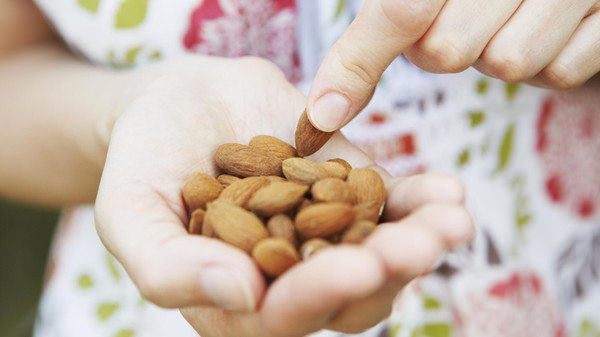
Today, we get about eight grams of fiber a day, yet researchers determined hunter-gatherer ancestors got about 100 grams from roots, berries, leaves, and plant foods.
Fiber helped our ancestors stay healthy, and getting sufficient amounts can help us maintain peak health today.
Among its roles, fiber helps prevent obesity and chronic disease. It decreases the speed food enters our bloodstream and increases the speed food exits through the digestive tract, which helps balance blood sugar. Fiber also helps quickly eliminate toxins from our gut and reduces appetite.
Fiber also fights cancer. One study showed how gut bacteria could utilize certain dietary fibers to turn on an anticancer gene and turn off colon cancer. In fact, fiber can reduce colon cancer risk to one-third and breast cancer by almost 40 percent.
Fiber also lowers cholesterol and reduces heart disease risk up to 40 percent. If we have diabetes, adding fiber to our diet may even help us use less insulin.
Fiber comes in two “flavors”: soluble and insoluble. Most benefits I described come from soluble fiber, which can also balance hormone levels, remove excess estrogen, make vitamins and minerals, and provide food for colon cells.
We get soluble fiber in fruits, vegetables, beans, nuts, seeds, and most whole grains. Gut bacteria metabolize this soluble fiber, creating the aforementioned benefits
Insoluble fiber, found in foods like bran, becomes equally important as a sort of scouring pad for our intestines. Insoluble fiber helps us stay regular by reducing constipation and other elimination problems.
Ideally, we want to get 30 – 50 grams of fiber every day. These seven strategies can help meet that quota.
- Get the flax. Buy a coffee grinder just for flax seeds, grind 1/2 cup at a time, and keep in a tightly sealed glass jar in the fridge or freezer. Eat two tablespoons of ground flax seeds a day in smoothies.
- Load up on legumes. Beans beat out everything else for fiber content. A cup of lentils carries a whopping 18 grams of fiber.
- Bulk up on vegetables. Few calories, high nutrient content, and fiber-rich are three reasons veggies should fill up to about two-thirds of our plate.
- Go easy on grains and fruit (but eat some). Aim for fiber-rich, gluten-free grains and lower-sugar fruits like berries. These are not an unlimited food, especially if you have weight or blood sugar issues.
- Don’t be afraid of the fat in nuts. A few handfuls of almonds, walnuts, pecans, or hazelnuts provide nutrients, protein, healthy fat, and yes, fiber. Enjoy them daily as snacks, but easy does it!
- Start slowly. Switching abruptly to a high-fiber diet can cause gas and bloating. Increase our fiber intake slowly until reaching about 50 grams a day.
- Consider a good fiber supplement. If we have trouble meeting our fiber quota, choose a supplement that contains both soluble and insoluble fiber with no sweeteners or additives. My favorite is a super-fiber called glucomannan (GM) that can absorb up to 50 times its weight in water, making it one of the most viscous dietary fibers known. Studies show two to four grams of GM per day created significant weight loss in overweight and obese individuals by installing a sense of fullness.
I know fiber isn’t a sexy topic, but I want you to get more of its numerous benefits. What’s your favorite high-fiber food? Share your strategies to get more of this nutrient in your diet below or on my Facebook page.
~
References
Howarth NC, Saltzman E, Roberts SB. Dietary fiber and weight regulation. Nutr Rev. 2001;59:129-139.
Burton-Freeman B. Dietary fiber and energy regulation. J Nutr. 2000; 130(2S Suppl):272S-275S
Vuksan V, Sievenpiper SL, Xu Z, et al. Konjac-Mannan and American Ginseng: Emerging alternative therapies for type 2 diabetes mellitus. J Am Coll Nutr. 2001;20(5Suppl):370S-380S.
Bourden I, Yokoyama W, Davis P, et al. Postprandial lipid, glucose, insulin, and cholecystokinin responses in men fed barley pasta enriched with beta-glucan. Am J Clin Nutr. 1999;69:55-63.
Baer DJ, Rumpler WV, Miles CW, Fahey GCJ. Dietary fiber decreases the metabolizable energy content and nutrient digestibility of mixed diets fed to humans. J Nutr. 1997;127: 579-586.
Chen H-L, Sheu WH, Tai T-S, Liaw Y-P, Chen Y-C. Konjac supplement alleviated hypercholesterolemia and hyperglycemia in type 2 diabetic subjects–a randomized double-blind trial. J Am Coll Nutr. 2003;22(1):36-42.
Vuksan V, Jenkins DJ, Spadafora P, et al. Konjac-mannan (glucomannan) improves glycemia and other associated risk factors for coronary heart disease in type 2 diabetes. A randomized controlled metabolic trial. Diabetes Care. 1999;22(6):913-919.
Walsh DE, Yaghoubian V, Behforooz A. Effect of glucomannan on obese patients: A clinical study. Int J Obes. 1984;8:289-293.
Reffo GC, Ghirardi PE, Forattini C. Glucomannan in hypertensive outpatients: Pilot clinical trial. Curr Ther Res. 1988; 44(1):22-27.
Livieri C, Novazi F, Lorini R. The use of highly purified glucomannan-based fibers in childhood obesity. Pediatr Med Chir. 1992;14(2):195-198.
Vita PM, Restelli A, Caspani P, Klinger R. Chronic use of glucomannan in the dietary treatment of severe obesity. Minerva Med. 1992;83(3):135-139.
Cairella M, Marchini G. Evaluation of the action of glucomannan on metabolic parameters and on the sensation of satiation in overweight and obese patients. ClinTer. 1995;146(4):269-274.
Arvill A, Bodin L. (1995). Effect of short-term ingestion of konjac glucomannan on serum cholesterol in healthy men. Am J Clin Nutr. 1995;61:585-589.
Vuksan V, Sievenpiper JL, Owen R, et al. Beneficial effects of viscous dietary fiber from konjac-mannan in subjects with the insulin resistance syndrome: Results of a controlled metabolic trial. Diabetes Care. 2000;23(1):9-14.
Gallaher DD, Gallaher CM, Mahrt GJ, et al. A glucomannan and chitosan fiber supplement decreases plasma cholesterol and increases cholesterol excretion in overweight normocholesterolemic humans. J Am Coll Nutr. 2002;21(5): 428-433.
Burley VJ, Paul AW, Blundell JE. Influence of a high-fibre food (myco-protein) on appetite: Effects on satiation (within meals) and satiety (following meals). Eur J Clin Nutr. 1993;47:409-418.
Hill AJ, Blundell JE. Macronutrients and satiety: The effects of a high protein or high carbohydrate meal on subjective motivation to eat and food preferences. Nutr Behav. 1986;3:133-144.
Astrup A, Vrist E, Quaade F. (1990). Dietary fibre added to a very low calorie diet reduces hunger and alleviates constipation. Int J Obes. 1990;14:105-112.
Pasman WJ, Saris WH, Wauters MA, Westerterp-Plantenga MS. Effect of one week of fibre supplementation on hunger and satiety ratings and energy intake. Appetite, 1997;29:77-87.
Liu S, Willett WC, Manson JE, Hu FP, Rosner B, Colditz G. Relation between changes in intakes of dietary fiber and grain products and changes in weight and development of obesity among middle-aged women. Am J Clin Nutr. 2003;78(5):920-927.
Author: Dr. Mark Hyman
Editor: Emily Bartran
Photo: Abd allah Foteih/Flickr


 Share on bsky
Share on bsky




Read 2 comments and reply